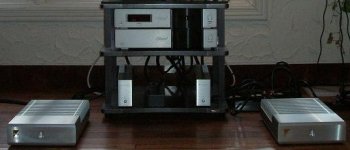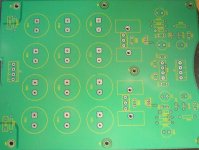These are "scary" proprietary devices , would be hard to find
in some parts of the world ,and could be emulated by proper
design. (Vbe tranny or diodes bolted right on ,or close ,to output)
Maybe it is good for Sony, JVC to use these devices for
thermally challenged consumer garbage , but DIY'ers should
stick to common devices.
Absolutely , thumbs down..OS
in some parts of the world ,and could be emulated by proper
design. (Vbe tranny or diodes bolted right on ,or close ,to output)
Maybe it is good for Sony, JVC to use these devices for
thermally challenged consumer garbage , but DIY'ers should
stick to common devices.
Absolutely , thumbs down..OS
ostripper said:use these devices for thermally challenged consumer garbage
Attachments
i read the silicon chip mag issue with that module.
can't really say im too interested.
my main diy power amp uses the 2 of the older 1996 silicon chip 185wrms modules and two individual 300va tranny power supplies with 16000uF of caps PER RAIL.
these new amps would be perfectly suitable for that chassis however these amps run cool and clean so no point upgrading them.
these thermal track power transistors would be great for under engineered stuff and amps that really get a work out i think.
can't really say im too interested.
my main diy power amp uses the 2 of the older 1996 silicon chip 185wrms modules and two individual 300va tranny power supplies with 16000uF of caps PER RAIL.
these new amps would be perfectly suitable for that chassis however these amps run cool and clean so no point upgrading them.
these thermal track power transistors would be great for under engineered stuff and amps that really get a work out i think.
Hi ostripper
I disagree with you, I think these devices have a lot of advantages and no disavantages, there are better power transistors available, it would be great if they incorporated this tehnology. I believe sanken also have some devices like this, will still look into it.
Jacco nice pic, no tell us what that system consists of. Are those DIY amps???
Guitar Joe, simple is better if it has same performance, and even more so when it has performance advantages.
I disagree with you, I think these devices have a lot of advantages and no disavantages, there are better power transistors available, it would be great if they incorporated this tehnology. I believe sanken also have some devices like this, will still look into it.
Jacco nice pic, no tell us what that system consists of. Are those DIY amps???
Guitar Joe, simple is better if it has same performance, and even more so when it has performance advantages.
homemodder said:system consists of.
Classe Omega preamp and Mr. Charles Hansen's GMAFB MX-R power amps.
Ya Kneu :the ones with ThermalTrak devices, 16 per channel.
(the screw type PS-connectors on the pcb are cool, i use them as well, manufactured by Riacon)
For DIY sniffers : a piccy of the Omega PS board with the first stage +/- series regulator for 1 channel, second stage is a separate shunt regulator (lateral mosfet) on a heatsink.
Attachments
ostripper said:These are "scary" proprietary devices , would be hard to find
in some parts of the world ,and could be emulated by proper
design. (Vbe tranny or diodes bolted right on ,or close ,to output)
Maybe it is good for Sony, JVC to use these devices for
thermally challenged consumer garbage , but DIY'ers should
stick to common devices.
Absolutely , thumbs down..OS
I disagree. On Semi keeps devices in their catalog for a long time. The ThermalTrak transistors are available from a wide number of sources, and they are seemingly easier to implement than the diode-incorporated Sanken's.
And the benefit -- as the thermal compensation is immediately adjacent to the junction the time for which compensation is effected is much faster than the temperature change crossing over the heat sink.
You could explore the benefit empirically and report on your results -- just set up an amplifier with Thermal Track devices -- for one set of experiments use a conventional VBE multiplier with the ThermalTraks, for the second hook up the incorporated diodes -- and report back to us with your results.
Hi jacoo
Keep that car wrecking woman away from my (chevy) suburban.
2002 Chevrolet Suburban mileage 54,000: Third and forth gear went out at 39,000 miles. Had transmission rebuilt. Old transmission had intermittently noticeable 1-2 shifts. Rebuilt has good 1-2 shifts and violent 1-2 shifts. Truck usually starts out with good 1-2 shifts and migrates into violent 1-2 shifts, but there doesn't seem to be any solid consistency to this pattern. One transmission mechanic using his Sun diagnostic unit saw a 1-2 error with a shift rate of .28. MAP, TBS, EGR, and everything else ok. Truck starts fine and engine has been checked. All other electrical seems to be fine.
Keep that car wrecking woman away from my (chevy) suburban.
2002 Chevrolet Suburban mileage 54,000: Third and forth gear went out at 39,000 miles. Had transmission rebuilt. Old transmission had intermittently noticeable 1-2 shifts. Rebuilt has good 1-2 shifts and violent 1-2 shifts. Truck usually starts out with good 1-2 shifts and migrates into violent 1-2 shifts, but there doesn't seem to be any solid consistency to this pattern. One transmission mechanic using his Sun diagnostic unit saw a 1-2 error with a shift rate of .28. MAP, TBS, EGR, and everything else ok. Truck starts fine and engine has been checked. All other electrical seems to be fine.

I totallyI disagree. On Semi keeps devices in their catalog for a long time. The ThermalTrak transistors are available from a wide number of sources, and they are seemingly easier to implement than the diode-incorporated Sanken's.
agree with the thermal compensation superiority of these devices ,
but not everyone lives in NJ,USA , some of our foreign comrades
have a hard time finding MJE 340's, so I like to stick to common
parts. Most of my amps use "street parts" recycled from
the dumpster(except for capacitors ).
Also,with the diode on the die wouldn't there be "cycling"
or a thermal feedback effect by having an OVER responsive
compensation scheme.?
I can't find them at newark.com,farnell has them on backorder
,google search :thermaltrak
no dealers, google search 2sc5200 ..dealers galore
I,m in the USA but I still don't get instant gratification!!!
I,d rather superglue the diode right to the face of a $1 2SC5200
before I.ll go in search of exotic parts.(still I'd like to try them..
,any dealers??)
http://search.digikey.com/scripts/DkSearch/dksus.dll?Detail?name=NJL3281DOS-ND
http://search.digikey.com/scripts/DkSearch/dksus.dll?Detail?name=NJL1302DOS-ND
the only problem with AVNET is NJL3281, 25pc min order and NJL1302 min 175 pc
and NJL1302 min 175 pc 

http://search.digikey.com/scripts/DkSearch/dksus.dll?Detail?name=NJL1302DOS-ND
the only problem with AVNET is NJL3281, 25pc min order
 and NJL1302 min 175 pc
and NJL1302 min 175 pc 

jackinnj said:I disagree. [snip]The ThermalTrak transistors are available from a wide number of sources, and they are seemingly easier to implement than the diode-incorporated Sanken's.
[snip]
I disagree too
In contrast, when you use the Onsemi ThermalTraks, YOU have to take care that the tempco tracking is set to the right value to avoid over- or undercompensation.
Jan Didden
bumphitsware said:Why do the Sankens have 5 diodes
on the PNP and 1 on the NPN ?
hitsware said:Why do the Sankens have 5 diodes
on the PNP and 1 on the NPN ?
The 5 diodes are schottky's. The reason for that particular organisation is that the total string of diodes comes close to the correct bias for the Darlingtons. But, more importantly, at 40mA bias and 2.5mA through the diodes, the tempco of the diode string matches the tempco of the Darlingtons. No messy bias transistors on the heatsink, but still almost perfect thermal stability.
Jan Didden
janneman said:
I disagree too. The ThermalTraks are more difficult to use than the Sankens. The Sankens' diode tempco is carefully matched to the transistors' (darlingtons) tempco at the recommended bias current.
In contrast, when you use the Onsemi ThermalTraks, YOU have to take care that the tempco tracking is set to the right value to avoid over- or undercompensation.
Jan Didden
The diodes of the Sanken's are directly connected to the base, the ThermalTrak's aren't -- I think that this limits the possibilities of their deployment. I believe that this is dicsussed on one of the memorialized Bob Cordell threads.
ThermalTraks are easier to obtain in the U.S. There is only one U.S. distributor of the Sankens, and that distributor is difficult for little guys to deal with so I have purchased them from the U.K. Getting a couple of samples from Allegro took a half-year.
jackinnj said:
There is only one U.S. distributor of the Sankens, and that distributor is difficult for little guys to deal with so I have purchased them from the U.K.
Not sure who you are dealing with in the US, but I found http://www.tenfourltd.com/ as a very reliable source for Sanken devices. They currently don't have STD03N/P in stock (quite unusual) but it's certainly worth asking for a quote. It's not going to be cheap, that's the reason I gave up using them quite some time ago. While they have certain advantages, I do not think they are worth the money you can purchase them in North America.
The only thing I'm missing in the Onsemi ThermalTracks is the Sanken devices pinout, allowing a so much better PCB layout.
- Status
- This old topic is closed. If you want to reopen this topic, contact a moderator using the "Report Post" button.
- Home
- Amplifiers
- Solid State
- On Semi ThermalTrak

